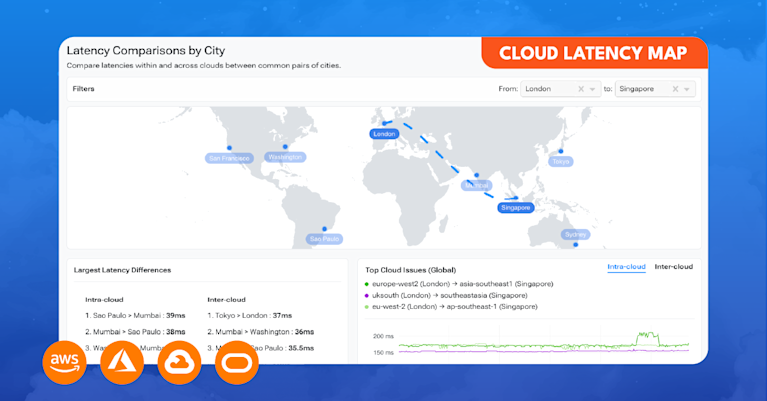Hurricane Helene Devastates Network Connectivity in Parts of the South

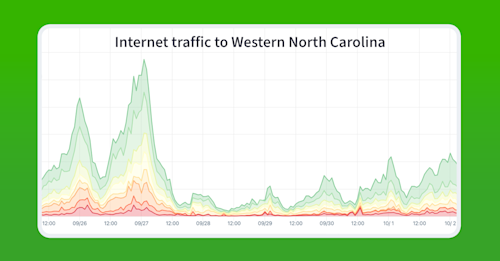
Summary
In this post, we dig into the impacts from Hurricane Helene which came ashore late last month wreaking destruction and severe flooding in the Southeastern United States. Using Kentik’s traffic data as well as Georgia Tech’s IODA, we detail the impacts in three of the hardest-hit states: Georgia, South Carolina, and North Carolina.
Hurricane Helene came ashore late last month wreaking destruction and severe flooding in its path. As of this writing, over 200 people tragically lost their lives, and countless others have been displaced from their homes (including one Kentik employee).
As the hard-hit regions continue to recover from the storm’s devastation, let’s take a moment to review what we’re seeing in terms of the impacts on internet connectivity in three of the hardest-hit states: Georgia, South Carolina, and North Carolina.
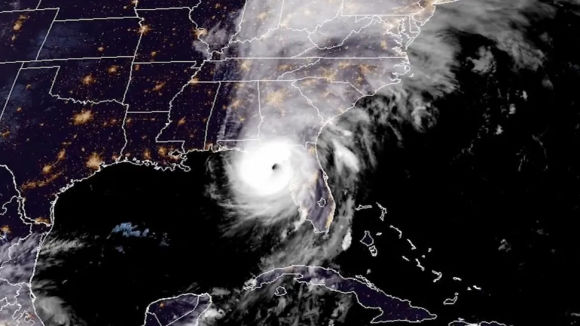
State-level impacts
Based on Kentik’s aggregate NetFlow data, traffic volumes to numerous providers in affected states experienced similar changes before and after the arrival of Helene. As the storm approached on September 26, providers handled a surge of traffic as residents of the southeast used the internet to closely follow the latest news about the storm.
Following the arrival of Helene, drops in traffic were seen around the region as the storm washed out roads and caused power outages. The immediate decline in traffic can also be attributed to people focusing on addressing their immediate needs that don’t require internet service.
Georgia
In Georgia, there were service impacts around the state. The graphic below illustrates traffic volume to three Georgia-based service providers: Clearwave Fiber (AS400511), ATC Broadband (AS11240), and the Brantley Telephone Company (AS394473).
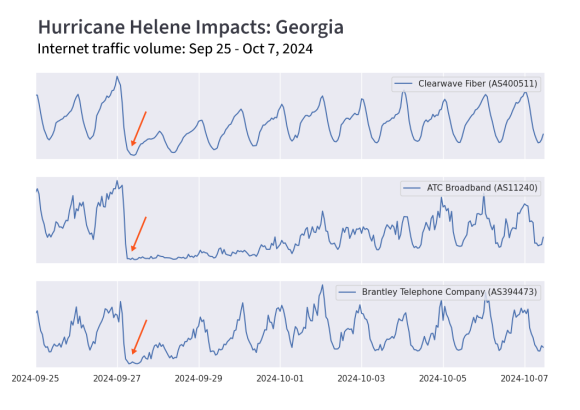
Seen below, the impact on Alma-based ATC Broadband is also well illustrated in IODA, the public outage analysis tool from our friends at Georgia Tech. In this graphic, the green line (representing BGP routes) is stable while the blue line (representing active measurements into AS11240) drops out early on September 27 before slowly recovering over the following days.

US broadband giant Comcast has three service regions within Georgia alone, as defined in their published geolocation data. These three regional networks experienced different levels of disruption based on their proximity to the storm’s path and as resilience of the infrastructure of the region. Their Atlanta Regional Network, the largest by traffic volume, showed little impact from Helene. In contrast, the Savannah Regional Network showed lower traffic levels beginning on September 27 before recovering as power was restored and Georgians in this part of the state began resuming normal life. It was the Augusta Regional Network that took the hardest blow from Helene and, as of this writing, has not yet fully recovered.

IODA also picked up disruptions to a variety of other providers around the state including Northland Cable Television (AS40285), the Pembroke Telephone Company (AS15313), and the Glenwood Telephone Company (AS397118) — all located in the southern half of the state.
South Carolina
As Helene continued moving north after Georgia, South Carolina was the next state to feel its wrath.
In the graphic below, we can observe the drop in traffic levels for three South Carolinian providers upon the arrival of Helene. Based on Kentik traffic data, Lexington-based Carolina Connect (AS397068), broadband provider Breezeline (AS11776), and Piedmont Rural Telephone (AS19212) all experienced significant drops in traffic as a result of the storm.
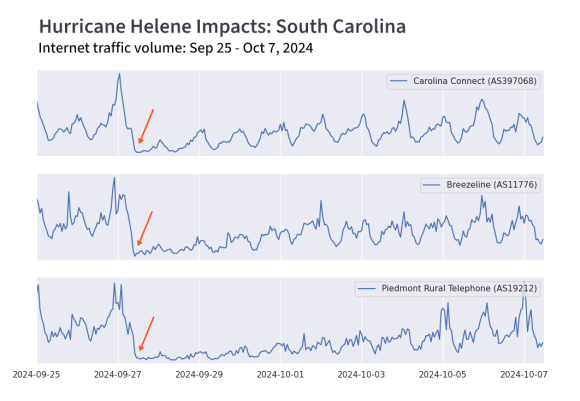
Using BGP and active measurement instead of traffic, IODA gives an alternative view of the disruptions in South Carolina. Below is its graphic for West Carolina Communications (AS10279). As was the case for ATC Broadband in Georgia, West Carolina Communications’ BGP routes stayed up (green line), while active measurement (i.e., responding pings) dropped precipitously on September 27 as last mile infrastructure became unreachable.

The drop in active measurement suggests that drops in traffic volume weren’t simply based on changes in user behavior but due to technical failures caused by the hurricane. Some other disruptions that were visible in IODA include TruVista (both AS20222 and AS21898) based in Tifton, Rock Hill Telephone (AS14615), and the Fujifilm manufacturing plant (AS32186) in Greenwood, SC.
North Carolina
Western North Carolina has been arguably the hardest-hit region. Below is a graphic based on traffic to the cities of Asheville, Hickory, Lenoir, and Morganton (subject to geolocation accuracy). As seen in previous charts, there was a peak of traffic on September 26, followed by a dramatic drop-off and slow recovery. By October 3, traffic levels were only at 50% of where they were prior to the storm.

In perhaps a bit of irony, the National Climatic Data Center (NCDC), based in Asheville, North Carolina, suffered an outage due to Helene. The NCDC is responsible for housing the world’s largest active archive of weather data and went offline at 14:43 UTC on September 27 before coming back online four days later. A Kentik BGP visualization of a NCDC route (192.153.129.0/24) is shown below.

Pictured below are the traffic plots to three service providers based in North Carolina. Based in Hendersonville, Morris Broadband (AS53488) was completely knocked offline for almost five days. Wilkes Communications (AS22191) and Skyline Telephone (AS23118) also experienced significant drops in traffic and are still in the process of recovering.
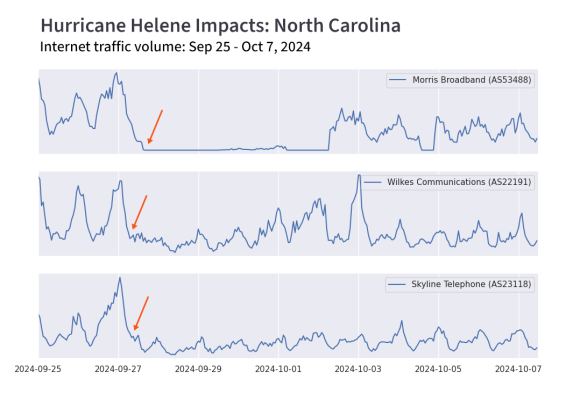
The IODA dashboard below gives another view of the Morris Broadband outage. AS53488’s BGP routes were withdrawn (green line) during three separate periods, while active measurement (blue line) showed a lack of responsiveness even when those routes were being announced. This suggests that while their address space returned to the global routing table, the last-mile connectivity was still down and unreachable.

Other significant impacts in Western North Carolina that were captured in IODA include Pyranah Communications (AS40063), BalsamWest (AS14430), and Skyrunner (AS53274).
Finally, AS81 operates the North Carolina Research and Education Network (NCREN) which saw three of its routes withdraw 16:22 UTC on September 27: 152.18.0.0/16 (University of North Carolina at Asheville), 152.30.0.0/16 and 152.30.10.0/24 (Western Carolina University in Cullowhee).
Conclusion
The devastation from Hurricane Helene was widespread and profound. In its aftermath, lay washed out roads, downed power lines, and disconnected communities. In this post, we have documented this disruption in terms of withdrawn BGP routes, drops in traffic levels, and non-responding ICMP pings, but none of these metrics can capture the toll on the people living in these places.
Along with basic necessities like food, water, and shelter, the ability to communicate is vital during a crisis like this. The loss of communication capabilities can hamper rescue and recovery efforts. Additionally, the inability to reach loved ones during a time of crisis like this can be stressful and traumatic. All of this underscores the importance of the work the internet industry does, whether in war-torn Ukraine or the hurricane-ravaged Blue Ridge Mountains of North Carolina.
Please follow this link for a list of charities and nonprofit groups that are accepting donations to help those affected by Hurricane Helene.
